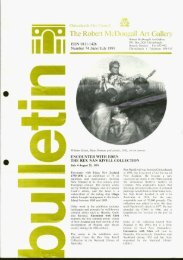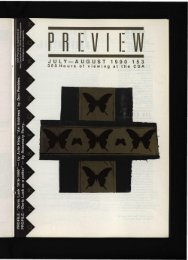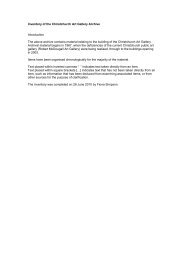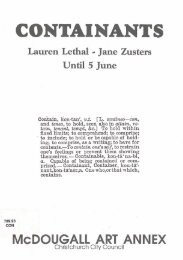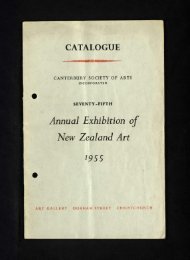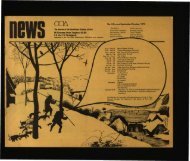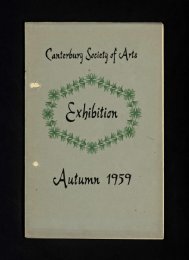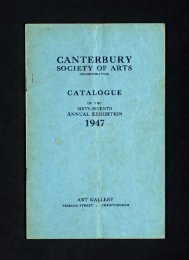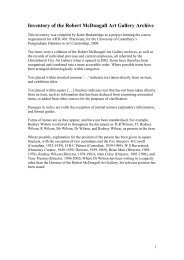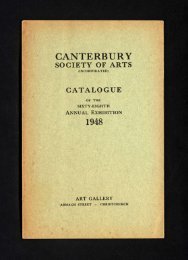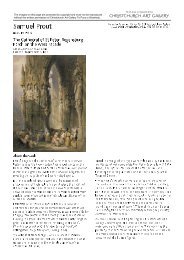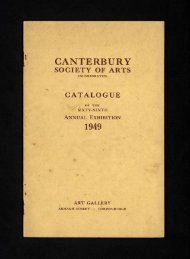Download (2.2 MB) - Christchurch Art Gallery
Download (2.2 MB) - Christchurch Art Gallery
Download (2.2 MB) - Christchurch Art Gallery
Create successful ePaper yourself
Turn your PDF publications into a flip-book with our unique Google optimized e-Paper software.
ITY MILBURN<br />
FELICITY MILBURN MAID<br />
TALKS WITH SPAIN TALKS WITH<br />
Felicity Milburn: One of the aims of<br />
SCAPE 2008 is to ‘unfold the already<br />
existing structures and ways of operating<br />
within the city’. What have you learned<br />
about <strong>Christchurch</strong> so far that will allow<br />
you to do this?<br />
Maider López: The project is explicitly<br />
designed to use a particular space in<br />
the city, with the aim of highlighting<br />
the space in question. It will focus on<br />
people’s daily experience of the space<br />
and of the city itself. Signs in the City<br />
Mall are the starting point – these public<br />
signs, whether used for advertising or<br />
for traffic, are ever-present in this part<br />
of the city. However, they have become<br />
such a presence in our daily lives that<br />
we often do not see them or hardly take<br />
any notice of them. The project attempts<br />
to make this fact evident.<br />
MAIDER LOPEZ<br />
MAIDER LÓPEZ<br />
SPAIN<br />
FM: Your work at <strong>Christchurch</strong><br />
<strong>Art</strong> <strong>Gallery</strong> highlights architectural<br />
elements – loudspeakers, motion sensors,<br />
fire alarms – that visitors to an art gallery<br />
are used to ignoring. What are you<br />
hoping to achieve by making the<br />
‘invisible’ visible in this way?<br />
ML: My work for <strong>Christchurch</strong> is<br />
divided into two parts: the first is in<br />
the public space of City Mall, and the<br />
second is inside the <strong>Gallery</strong>. In Cashel<br />
Street, people will be positioned in<br />
unusual places so as to hide all the<br />
advertising and traffic signs that can<br />
be seen from specific points of view.<br />
However, inside the <strong>Gallery</strong> I will<br />
showcase the signs that the <strong>Gallery</strong><br />
uses for the operation of their facility.<br />
Usually these signs are kept hidden in<br />
order to highlight the pieces of art<br />
on display, but in this case I will try<br />
to highlight these signs and integrate<br />
them with the normal <strong>Gallery</strong> signs. As<br />
a result, in City Mall the visible will be<br />
made invisible, while at the <strong>Gallery</strong> the<br />
invisible will be visible.<br />
FM: Your work often plays with the idea<br />
of the absurd. Does humour allow you<br />
to achieve things you wouldn’t be able<br />
to otherwise?<br />
ML: I am interested in the idea of<br />
creating something odd or absurd from<br />
what is seemingly a totally normal<br />
everyday act. Thus, in the blink of an eye,<br />
daily life becomes extraordinary. That<br />
turns what is real into scenography.<br />
In order to do this, humour plays a<br />
very important role in my projects, as<br />
it allows the public to have a greater<br />
connection with my work.<br />
FM: Many of your previous projects<br />
have required considerable public<br />
participation, such as Playa (2006),<br />
in which sunbathers on a beach<br />
were asked to use only red towels,<br />
or Ataskoa (2005), for which you<br />
choreographed a major case of<br />
gridlock on a mountain road. How<br />
has this participation complicated and<br />
enriched your practice?<br />
ML: It is certainly true that, on many<br />
occasions, my work is carried out with<br />
public participation. It is, in fact, the<br />
people who made the project. In Playa<br />
everyone used red towels in order to<br />
transform a beach scene in August into<br />
a highly implausible scene. Ataskoa was a<br />
public project with a festive atmosphere<br />
in which people were asked to create a<br />
traffic jam halfway up a normally quiet<br />
mountain road. This decontextualised an<br />
almost routine situation in our everyday<br />
lives and made it possible to see this<br />
situation from a different perspective.<br />
At Dunafelfedes in Budapest, people at<br />
Chain Bridge simultaneously opened<br />
their umbrellas – which were all the<br />
same colour as the Danube. From<br />
an aerial perspective the bridge had<br />
‘vanished’, unifying the people with<br />
the water. These projects have been<br />
made with the active participation of<br />
the public to show people’s capacity to<br />
transform urban spaces and to create<br />
new cities with the use of space.<br />
Interview translated from Spanish by<br />
Rosa Marina San José Velarde.<br />
Sponsored by:<br />
SEACEX Design & <strong>Art</strong>s<br />
Fulton Hogan<br />
The <strong>Art</strong>s Centre<br />
Maider López AdosAdos Guggenheim Bilbao, Bilbao, 2007<br />
10 11



